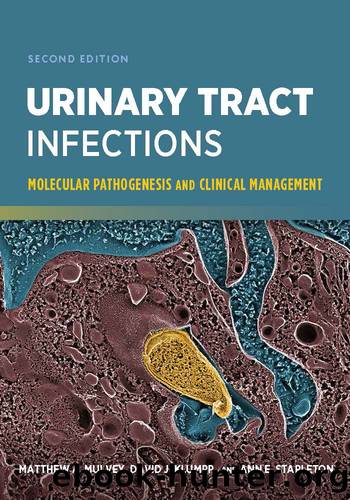Urinary Tract Infections by Matthew A. Mulvey

Author:Matthew A. Mulvey
Language: eng
Format: epub
Publisher: Wiley
Published: 2017-01-24T00:00:00+00:00
Evidence for Occurrence of Pathoadaptive Mutations in UPEC
Observations of phenotypic variations
Several types of phenotypic variation have been reported earlier to occur in urinary E. coli isolates from the same patient. It has been shown that urines from patients with UTI commonly yield mixed growths of different colony types of E. coli, with the latter found to be variants of single infecting strains (58). Thus, whether the colony heterogeneity is caused by mutation or by phase variation (which was not then determined), care should be exercised in the interpretation of apparently mixed growths from urine. It has been observed that 30% to 75% of successive isolates from recurrent cystitis or asymptomatic bacteriuria tend to lose the O-antigen and convert from clones with an O-typable, lipopolysaccharide (LPS), smooth-colony morphology to ones with O-nontypable rough or, more often, semi-rough-colony morphology (59â62). The LPS semi-rough-colony morphology is characterized by formation of smooth colonies on agar and, therefore, these variants are indistinguishable from the true LPS-smooth variants on the agar. These strains, however, are not typable by various O-antisera and tend to autoagglutinate in normal saline after boiling. The change from smooth to semi-rough or rough clones involves a progressive loss of long O-specific side-chains, as was shown by gel-column filtration and gas-liquid chromatography (62). Interestingly, the LPS-smooth/-rough phenotypic variation is common among lung P. aeruginosa isolates derived from later stages of infection in patients with cystic fibrosis (63, 64). The exact genetic nature of the LPS variation is unknown, but is possibly due to different types of mutation in the multi-kb rfb locus (64, 65). The adaptive advantage of O-antigen loss might be in the ability of these bacteria to escape host defenses guided by anti-LPS antibodies or innate immunity, but its true value remains to be determined. Interestingly, a naturally occurring shift in the O-serotype can also be induced by a point mutation in wbdA genes encoding mannosyltransferase or wzz controlling chain length of O-antigen (66, 67).
Besides the loss of O-antigen, E. coli strains from patients with recurrent cystitis may lose the ability to express flagella or shift capsular antigenicity (59). Variations in colony morphology could reflect various types of adaptive differentiation within a spatially organized bacterial population, e.g., grown in parallel on a surface and in a liquid phase (68). Another type of variation described among E. coli strains causing long-term and, usually, mild symptomatic UTIs is the occurrence of auxotrophic clones, primarily cysteine, thymidine, glutamine, and thiamine-requiring strains (69, 70). Such auxotrophs grow on the surface of nutrient agar as very small translucent colonies. Interestingly, the emergence of auxotrophs and small colony-forming variants is typical for other pathogens causing chronic infections, like lung P. aeruginosa and Staphylococcus aureus isolates (71, 72). It was suggested that selection for such variants is induced by certain types of antibiotic therapy, by high amino acid concentration in the patientâs fluids infected by the bacteria, or by prolonged intracellular persistence of such variants.
Download
This site does not store any files on its server. We only index and link to content provided by other sites. Please contact the content providers to delete copyright contents if any and email us, we'll remove relevant links or contents immediately.
When Breath Becomes Air by Paul Kalanithi(7264)
Why We Sleep: Unlocking the Power of Sleep and Dreams by Matthew Walker(5642)
Paper Towns by Green John(4169)
The Immortal Life of Henrietta Lacks by Rebecca Skloot(3826)
The Sports Rules Book by Human Kinetics(3588)
Dynamic Alignment Through Imagery by Eric Franklin(3489)
ACSM's Complete Guide to Fitness & Health by ACSM(3469)
Kaplan MCAT Organic Chemistry Review: Created for MCAT 2015 (Kaplan Test Prep) by Kaplan(3423)
Introduction to Kinesiology by Shirl J. Hoffman(3301)
Livewired by David Eagleman(3122)
The River of Consciousness by Oliver Sacks(2992)
Alchemy and Alchemists by C. J. S. Thompson(2911)
The Death of the Heart by Elizabeth Bowen(2901)
Descartes' Error by Antonio Damasio(2731)
Bad Pharma by Ben Goldacre(2730)
Kaplan MCAT Behavioral Sciences Review: Created for MCAT 2015 (Kaplan Test Prep) by Kaplan(2492)
The Gene: An Intimate History by Siddhartha Mukherjee(2491)
The Fate of Rome: Climate, Disease, and the End of an Empire (The Princeton History of the Ancient World) by Kyle Harper(2436)
The Emperor of All Maladies: A Biography of Cancer by Siddhartha Mukherjee(2431)
